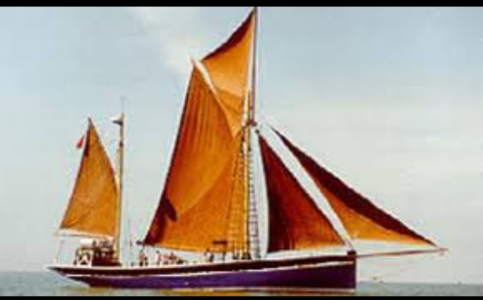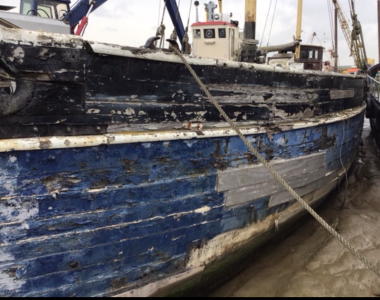Rum_Pirate
Well-Known Member
This was relayed to me by a third party
Anyone want to do a Leo Sampson or a restoration?
My Father, Arthur George Thomas Stevens (“Steve”) was born in Loughton, Essex, in 1914, where his father, also Arthur, was the station sergeant at Loughton Police Station. Steve was brought up by a strict father and, the first time he got the chance, ran away to sea. He joined the Merchant Navy and worked his way up to become an officer. Then, for reasons best known only to Steve, he left the Merchant Navy and signed on as a humble PC in the Metropolitan Police, training at Hendon and then being stationed at Tower Bridge Police Station.
When war broke out in 1939, Steve was quickly commissioned into the Royal Navy and trained in Scotland, before becoming a commander of tank landing craft, crossing to Normandy on D+1 (the day after D-Day). Once the allied forces left the beaches and Steve’s flotilla had delivered all they could, they were involved in bridge building (Bailley Bridges) to cross many rivers where retreating German had destroyed the existing ones.
After the war, Steve was involved in bomb disposal on the South Coast of Britain, stationed close to Corfe, Dorset, after which he returned to the police, though still on the Royal Navy Reserve as a Lieutenant Commander. Steve retained his connections with the Admiralty and, in 1950, started the Bermondsey Sea Cadets in London’s Docklands. In those days the boys from the docks were a rough bunch, but were knocked into shape by “The CO”, assisted by the bo’sun and a series of tough Petty Officers., Over the years, many of these lads made their way into the Merchant Navy and Royal Navy.
Steve managed to negotiate the purchase of a Brixham Trawler, a 31-ton wooden ketch, which was moved to Surrey Commercial Docks, where the cadets inherited a boathouse and a massive underground air raid shelter. The Jacaranda, as she was known then, was moored in Stave Dock, which was soon renamed Steve Dock after my father. Bermondsey Sea Cadets thrived at that venue for some 35 years before the docks were closed, when she spent a while in St Katherine Dock and, finally, Tilbury. She had been re-engineered as a sail training vessel, with 3 offices’ cabins with double bunks, and some 32 cadet berths.
It seems that Steve, known at Tower Bridge Police Station as “the old man”, managed to sneak off regularly from his police duties to tend to the ongoing needs of the cadets and “that bloody boat” as my mother called it. Perhaps the powers that be (or were) turned a blind eye because getting boys off the street and training them for a useful career probably prevented more crime than police work ever did.
The Kenya Jacaranda had become somewhat famous during her life. She started out as the Torbay Lass, built in 1923. She was 77 feet long, with a beam (width) of 18 feet, a main mast around 68 feet and a main boom of 32 feet. She was built to trawl for fish in the Irish and North seas, as far North as Iceland. Her construction marked the beginning of the end of fishing under sail from Brixham and her configuration was traditional and basic. She had no engine, but did have a coal-fired steam boiler to power the hauling winch for the nets (a feature common to sailing fishing vessels from around the coasts of the UK from the early 20th century). There was no deck house, with the crew of four being accommodated in the aft sail lockers with very basic provision for sleeping and eating.
By 1938 Torbay Lass’s fishing days were over. However, records show that she had a distinguished career and was a notably good sailing vessel, being involved in 1935 in rescuing the disabled sailing collier Welcome by towing her under sail away from Pendeen Head back to Newlyn. This is believed to be the last salvage tow under sail in the world, a tow of some 24 hours. In 1936 Torbay Lass was awarded the King George V Cup for winning the Brixham Trawler Race in that year, thereby demonstrating her capabilities and turn of speed. A few years ago a supporter unearthed some Pathe News footage on Google -
Under new ownership in 1939 and having undergone a refit as a pleasure yacht which included the installation of 2 engines, it would appear that Torbay Lass served out the war years in Lowestoft as anti-seaplane cover and accommodation. In 1944 it was recorded by Lady Genesta Hamilton (who subsequently bought her in 1945) that Torbay Lass was perfect for private use, with a large aft saloon, four big double berth cabins, two lavatories, a roomy fo’c’s’le and a deck house. Lady Hamilton renamed her Kenya Jacaranda in view of her intended new home on the East African seaboard, but it is not clear that she ever made it to the Indian Ocean.
Anyone want to do a Leo Sampson or a restoration?
My Father, Arthur George Thomas Stevens (“Steve”) was born in Loughton, Essex, in 1914, where his father, also Arthur, was the station sergeant at Loughton Police Station. Steve was brought up by a strict father and, the first time he got the chance, ran away to sea. He joined the Merchant Navy and worked his way up to become an officer. Then, for reasons best known only to Steve, he left the Merchant Navy and signed on as a humble PC in the Metropolitan Police, training at Hendon and then being stationed at Tower Bridge Police Station.
When war broke out in 1939, Steve was quickly commissioned into the Royal Navy and trained in Scotland, before becoming a commander of tank landing craft, crossing to Normandy on D+1 (the day after D-Day). Once the allied forces left the beaches and Steve’s flotilla had delivered all they could, they were involved in bridge building (Bailley Bridges) to cross many rivers where retreating German had destroyed the existing ones.
After the war, Steve was involved in bomb disposal on the South Coast of Britain, stationed close to Corfe, Dorset, after which he returned to the police, though still on the Royal Navy Reserve as a Lieutenant Commander. Steve retained his connections with the Admiralty and, in 1950, started the Bermondsey Sea Cadets in London’s Docklands. In those days the boys from the docks were a rough bunch, but were knocked into shape by “The CO”, assisted by the bo’sun and a series of tough Petty Officers., Over the years, many of these lads made their way into the Merchant Navy and Royal Navy.
Steve managed to negotiate the purchase of a Brixham Trawler, a 31-ton wooden ketch, which was moved to Surrey Commercial Docks, where the cadets inherited a boathouse and a massive underground air raid shelter. The Jacaranda, as she was known then, was moored in Stave Dock, which was soon renamed Steve Dock after my father. Bermondsey Sea Cadets thrived at that venue for some 35 years before the docks were closed, when she spent a while in St Katherine Dock and, finally, Tilbury. She had been re-engineered as a sail training vessel, with 3 offices’ cabins with double bunks, and some 32 cadet berths.
It seems that Steve, known at Tower Bridge Police Station as “the old man”, managed to sneak off regularly from his police duties to tend to the ongoing needs of the cadets and “that bloody boat” as my mother called it. Perhaps the powers that be (or were) turned a blind eye because getting boys off the street and training them for a useful career probably prevented more crime than police work ever did.
The Kenya Jacaranda had become somewhat famous during her life. She started out as the Torbay Lass, built in 1923. She was 77 feet long, with a beam (width) of 18 feet, a main mast around 68 feet and a main boom of 32 feet. She was built to trawl for fish in the Irish and North seas, as far North as Iceland. Her construction marked the beginning of the end of fishing under sail from Brixham and her configuration was traditional and basic. She had no engine, but did have a coal-fired steam boiler to power the hauling winch for the nets (a feature common to sailing fishing vessels from around the coasts of the UK from the early 20th century). There was no deck house, with the crew of four being accommodated in the aft sail lockers with very basic provision for sleeping and eating.
By 1938 Torbay Lass’s fishing days were over. However, records show that she had a distinguished career and was a notably good sailing vessel, being involved in 1935 in rescuing the disabled sailing collier Welcome by towing her under sail away from Pendeen Head back to Newlyn. This is believed to be the last salvage tow under sail in the world, a tow of some 24 hours. In 1936 Torbay Lass was awarded the King George V Cup for winning the Brixham Trawler Race in that year, thereby demonstrating her capabilities and turn of speed. A few years ago a supporter unearthed some Pathe News footage on Google -
Under new ownership in 1939 and having undergone a refit as a pleasure yacht which included the installation of 2 engines, it would appear that Torbay Lass served out the war years in Lowestoft as anti-seaplane cover and accommodation. In 1944 it was recorded by Lady Genesta Hamilton (who subsequently bought her in 1945) that Torbay Lass was perfect for private use, with a large aft saloon, four big double berth cabins, two lavatories, a roomy fo’c’s’le and a deck house. Lady Hamilton renamed her Kenya Jacaranda in view of her intended new home on the East African seaboard, but it is not clear that she ever made it to the Indian Ocean.


